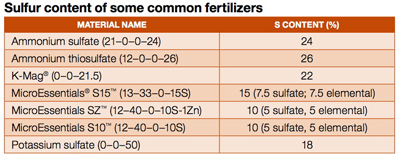The first occurrences of sulfur (S) deficiency in corn were reported in the 1960s. At the time, sulfur deficiency was virtually unheard of. Textbooks devoted chapters to nitrogen (N), phosphorus (P) and potassium (K) and their roles in crop production. Sulfur received only short paragraphs.
To sustain optimum crop yields, the S balance in soils will need to be maintained through supplemental S
Today, the situation is quite different. Since the late 1980s, university agronomists from New York to Kansas, and from Michigan to Alabama, have been observing sulfur deficiency in crops and advising growers on the importance of supplemental sulfur. With this change, S has become the fourth “essential nutrient.” It’s a component of numerous protein enzymes that regulate photosynthesis and nitrogen fixation. In fact, when S is limiting, there is less chlorophyll production, which makes the younger leaves of the plant appear yellow, a symptom sometimes confused with N deficiency.
Putting S out of balance
What has changed to bring about a need for supplemental sulfur in crop production?
· Decreased S deposition from rain and air. Since the 1970 Clean Air Act, emissions of sulfur dioxide have decreased dramatically, resulting in reduced deposition from rain and air.
· Changing fertilization practices. A switch away from ammonium sulfate as a source of N and decreased use of single superphosphate, which contains some S, means we’re adding less S to soils. Manure use also has changed.
· Increased crop removal. An increase in both grain and forage yields results in more rapid depletion of S from soils.
– A 180 bushels per acre corn crop removes about 14 pounds S per acre.
– Alfalfa removes approximately 6 pounds S per acre per ton produced.
– A 40 bushels per acre wheat yield will remove about 5 pounds S per acre.
· Sulfur is mobile in the soil. Excessive rainfall or irrigation water can move SO₄–S through the soil, particularly when soils are sandy.
Assessing the need for sulfur
As more signs of sulfur deficiency appear in crops, a growing number of producers will wonder if they need to supplement S. To identify where supplemental S will be beneficial, it’s important to understand sulfur’s role as a plant nutrient.
Identifying areas with S deficiency often begins with organic matter content of the soil. Fields with low organic matter and long histories of forage or silage production, or continuous corn systems with no manure additions, are more likely to exhibit S deficiency. Soil tests can confirm some nutrient deficiencies, but with S as with N, it’s difficult to get a reliable assessment of available S from soil testing because of sulfur’s mobility in the soil and the varying rates of S mineralization from crop residues. Tissue testing, in this instance, is considered more reliable, and comparing samples of the same hybrid within the same fields (between poor and good areas) may be the best strategy.
Visual symptoms also are an indicator, and plants with severe deficiencies show yellow or white streaks along the leaf veins that may stretch the full length of the newer, upper leaves. Probably the most reliable way to know whether a sulfur application will result in a positive response is to apply some in strips and measure for possible differences in yield.
Choosing a source of supplemental sulfur
Several products are available for correcting or preventing a sulfur deficiency. When choosing a product, remember that sulfur forms vary in their availability for plant growth. Plants can readily take up sulfate (SO₄), so this form is preferred for corn and small-grain production since it’s immediately available to developing roots, helping plants get off to a faster start.
Elemental sulfur (S) must be oxidized into SO₄ by soil bacteria before plants can take it up. This takes time and is slowed by cool spring temperatures. Elemental sulfur is more of a slow-release fertilizer and can be used in a soil maintenance program or by plants later in the season. Choosing a fertilizer source containing elemental sulfur also helps ensure S is available to plants all season long because it isn’t as mobile as sulfate, which can move out of the root zone when precipitation is high.
Sources of sulfur for plants

There are several fertilizers available to supply S when it’s needed. The MicroEssentials®family of products provides season-long availability of S by providing both the elemental and sulfate forms. K-Mag® fertilizer is virtually 100 percent water soluble and provides K, magnesium (Mg) and S, which are immediately available to plants. Your local agronomist, crop consultant or fertilizer dealer can help you assess the right product to optimize yields in your crop production program.
MicroEssentials and K-Mag are registered trademarks of The Mosaic Company. For more information on more information on premium fertilizer products, click here.